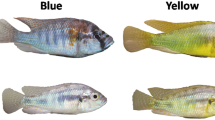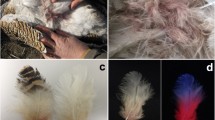Summary
The skin of the lizard, Anolis carolinensis, changes rapidly from bright green to a dark brown color in response to melanophore stimulating hormone (MSH). Chromatophores responsible for color changes of the skin are xanthophores which lie just beneath the basal lamina containing pterinosomes and carotenoid vesicles. Iridophores lying immediately below the xanthophores contain regularly arranged rows of reflecting platelets. Melanophores containing melanosomes are present immediately below the iridophores. The ultrastructural features of these chromatophores and their pigmentary organelles are described. The color of Anolis skin is determined by the position of the melanosomes within the melanophores which is regulated by MSH and other hormones such as norepinephrine. Skins are green when melanosomes are located in a perinuclear position within melanophores. In response to MSH, they migrate into the terminal processes of the melanophores which overlie the xanthophores above, thus effectively preventing light penetration to the iridophores below, resulting in skins becoming brown. The structural and functional characteristics of Anolis chromatophores are compared to the dermal chromatophore unit of the frog.
Similar content being viewed by others
References
Alexander, N. J., Fahrenbach, W. H.: The dermal chromatophores of Anolis carolinensis (Reptilia, Iguanidae). Amer. J. Anat. 126, 41–56 (1969).
Bagnara, J. T.: Cytology and cytophysiology o c- non-melanophore pigment cells. Intern. Rev. Cytol. 20, 173–205 (1966).
—, Hadley, M. E., Taylor, J. D.: Regulation of bright-colored pigmentation of amphibians. Gen. comp. Endocr., Suppl. 2, 425–438 (1969).
— Taylor, J. D., Hadley, M. E.: The dermal chromatophore unit. J. Cell Biol. 38, 67–79 (1968).
Bartley, J. A.: M. A. T. Thesis, Brown University, Providence, R. I. (1966).
Bennett, D., Radimska, O.: Flotation-fluid staining: Toluidine Blue applied to Maraglas sections. Stain Technol. 41, 349–350 (1966).
Bikle, D., Tilney, L. G., Porter, K. R.: Microtubules and pigment migration in melanophores of Fundulus heteroclitus L. Protoplasma 61, 322–345 (1966).
Breathnach, A. S., Poyntz, S.: Electron microscopy of pigment cells in tail skin of Lacerta vivipara. J. Anat. (Lond.) 100, 549–569 (1966).
Fitzpatrick, T. B., Breathnach, A. S.: Das epidermale Melanin-Einheit-System. Derm. Wschr. 147, 481–489 (1963).
Forsdahl, K. A.: Mechanism of pigment-granule movement in melanophores of the lizard Anolis carolinensis. Nytt. Mag. Zool. 8, 38–44 (1959).
Geldern, C. E., von: Color changes and structures of the skin of Anolis carolinensis. Proc. Calif. Acad. Sci. 10, 77–117 (1921).
Goldman, J. M., Hadley, M. E.: In vitro demonstration of adrenergic receptors controlling melanophore responses of the lizard, Anolis carolinensis. J. Pharmacol. exp. Ther. 166, 1–7 (1969).
Hadley, M. E.: Ph. D. Thesis, Brown University, Providence, R. I. (1966).
— Bagnara, J. T.: Integrated nature of chromatophore responses in the in vitro frog skin bioassay. Endocrinology 84, 69–82 (1969).
— Goldman, J. M.: Physiological color changes in reptiles. Amer. Zool. 9, 489–504 (1969).
— Quevedo, W.C.: Vertebrate epidermal melanin unit. Nature (Lond.) 209, 1334–1335 (1966).
— Quevedo, W.C.: The role of epidermal melanocytes in adaptive color changes in amphibians. Advanc. Biol. Skin 8, 337–359 (1967).
Horowitz, S. B.: The energy requirements of melanin granules aggregation and dispersion in melanophores of Anolis carolinensis. J. cell. comp. Physiol. 51, 341–357 (1958).
Keller, R.: Über den Farbenwechsel des Chamäleons und einiger anderer Reptilien. Pflügers Arch. ges. Physiol. Bd. 61, 123–168 (1891).
Kleinholz, L. H.: Studies in reptilian colour changes. III. Control of the light phase and behaviour of isolated skin. J. exp. Biol. 15, 492–499 (1938).
Luft, J. H.: Improvements in epoxy resin embedding methods. J. biophys. biochem. Cytol. 9, 409–414 (1961).
Matsumoto, J.: Studies on fine structure and cytochemical properties of erythrophores in swordtail, Xiphophorus helleri, with special reference to their pigment granules (pterinosomes). J. Cell Biol. 27, 493–504 (1965).
— Obika, M.: Morphological and biochemical characterization of goldfish erythrophores and their pterinosomes. J. Cell Biol. 39, 233–250 (1968).
Obika, M., Matsumoto, J.: Morphological and biochemical studies on amphibian bright-colored pigment cells and their pterinosomes. Exp. Cell Res. 52, 646–659 (1968).
Parker, G. H.: Animal colour changes and their neurohumours. Cambridge: Univ. Press 1948.
Reynolds, E. S.: The use of lead citrate at high pH as an electron opaque stain in electron microscopy. J. Cell Biol. 17, 208 (1963).
Sand, A.: The comparative physiology of colour response in reptiles and fishes. Biol. Rev. 10, 361–382 (1935).
Setoguti, T.: Ultrastructure of guanophores. J. Ultrastruct. Res. 18, 324–332 (1967).
Shizume, K., Lerner, A. B., Fitzpatrick, T. B.: In vitro bioassay for the melanocyte stimulating hormone. Endocrinology 54, 553–560 (1954).
Taylor, J. D.: Electron microscopy of iridophores in hypophysectomized Rana pipiens larvae. Amer. Zool. 6, 578 (1966).
—: Ph. D. Thesis, Univ. Arizona, Tucson, Arizona (1967).
—: The effects of intermedin on the ultrastructure of amphibian iridophores. Gen comp. Endocr. 12, 405–416 (1969).
Watson, M. L.: Staining of tissue sections of electron microscopy with heavy metals. J. biophys. biochem. Cytol. 4, 475–478 (1958).
Wise, G. E.: An ultrastructural comparison of expanded and punctate melanophores in the Pacific Coast Treefrog, Hyla regilla. Amer. Zool. 6, 613 (1966).
Author information
Authors and Affiliations
Additional information
This study was supported in part by GB-8347 from the National Science Foundation.
Contribution No. 244, Department of Biology, Wayne State University.
The authors are indebted to Dr. Joseph T. Bagnara for his encouragement during the study and to Dr. Wayne Ferris for his advice and the use of his electron microscope laboratory.
Rights and permissions
About this article
Cite this article
Taylor, J.D., Hadley, M.E. Chromatophores and color change in the lizard, Anolis carolinensis . Z. Zellforsch. 104, 282–294 (1970). https://doi.org/10.1007/BF00309737
Received:
Issue Date:
DOI: https://doi.org/10.1007/BF00309737




